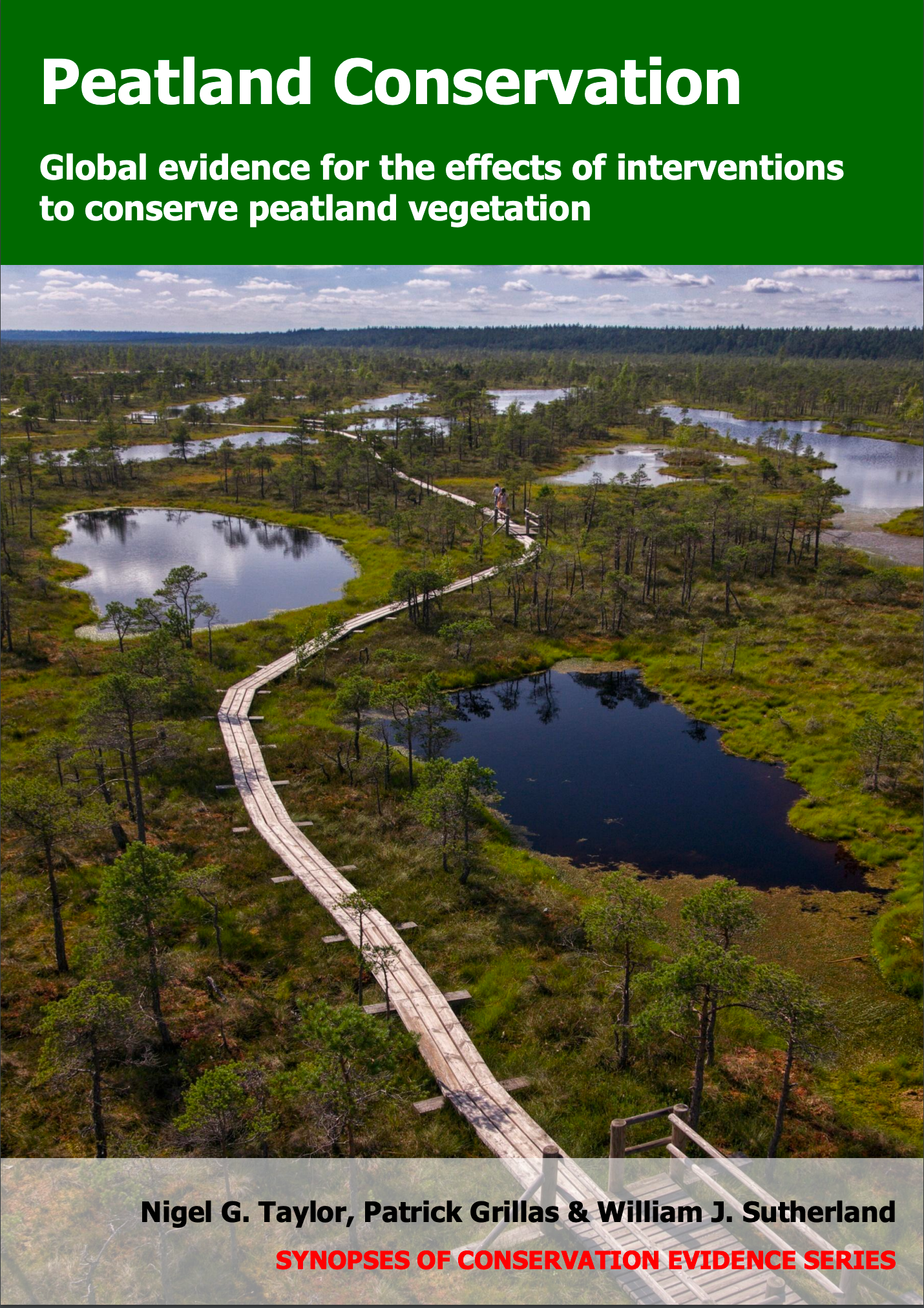Actions to conserve biodiversity
We have summarised evidence from the scientific literature about the effects of actions to conserve wildlife and ecosystems.
Review the evidence from the studies
Not sure what Actions are? Read a brief description.
Search for evidence
e.g. "frogs chytrid"
125 Actions found
Refine
Hide
125 Actions found
Download Actions
| 0 selected |
|
Order results by:
| Action | Effectiveness | Studies | Category | |
|---|---|---|---|---|
|
Raise awareness amongst the public (wild fire) Action Link |
No evidence found (no assessment) | 0 |
|
|
|
Raise awareness through engaging volunteers in peatland management or monitoring Action Link |
No evidence found (no assessment) | 0 |
|
|
|
Reduce fertilizer or herbicide use near peatlands Action Link |
No evidence found (no assessment) | 0 |
|
|
|
Reduce frequency of harvest (of wild biological resources) Action Link |
No evidence found (no assessment) | 0 |
|
|
|
Reduce intensity of harvest (of wild biological resources) Action Link |
Unknown effectiveness (limited evidence) | 1 |
|
|
|
Reduce intensity of livestock grazing Action Link |
Unknown effectiveness (limited evidence) | 1 |
|
|
|
Reduce water level of flooded peatlands Action Link |
No evidence found (no assessment) | 0 |
|
|
|
Remove oil from contaminated peatlands Action Link |
No evidence found (no assessment) | 0 |
|
|
|
Remove plant litter to maintain or restore disturbance Action Link |
Unknown effectiveness (limited evidence) | 2 |
|
|
|
Remove pollutants from waste gases before they enter the environment Action Link |
Unknown effectiveness (limited evidence) | 1 |
|
|
|
Remove residential or commercial development from peatlands Action Link |
No evidence found (no assessment) | 0 |
|
|
|
Remove upper layer of peat/soil (before planting) Action Link |
No evidence found (no assessment) | 0 |
|
|
|
Remove upper layer of peat/soil (without planting) Action Link |
Likely to be beneficial | 10 |
|
|
|
Remove vegetation that could compete with planted peatland vegetation Action Link |
Unknown effectiveness (limited evidence) | 1 |
|
|
|
Replace blocks of vegetation after mining or peat extraction Action Link |
Unknown effectiveness (limited evidence) | 2 |
|
|
|
Reprofile/relandscape peatland (before planting) Action Link |
Likely to be beneficial | 4 |
|
|
|
Reprofile/relandscape peatland (without planting) Action Link |
Unknown effectiveness (limited evidence) | 1 |
|
|
|
Restore natural water level fluctuations Action Link |
No evidence found (no assessment) | 0 |
|
|
|
Restore/create peatland vegetation (multiple interventions) Action Link |
Likely to be beneficial | 8 |
|
|
|
Restore/create peatland vegetation using the moss layer transfer technique Action Link |
Likely to be beneficial | 4 |
|
|
|
Restore/create peatlands in areas that will be climatically suitable in the future Action Link |
No evidence found (no assessment) | 0 |
|
|
|
Restrict pedestrian access to peatlands Action Link |
No evidence found (no assessment) | 0 |
|
|
|
Restrict vehicle use on peatlands Action Link |
No evidence found (no assessment) | 0 |
|
|
|
Retain or create buffer zones between pollution sources and peatlands Action Link |
No evidence found (no assessment) | 0 |
|
|
|
Retain/create habitat corridors across service corridors Action Link |
No evidence found (no assessment) | 0 |
|
Download Actions
| 0 selected |
|

Peatland Conservation - Published 2018
Peatland Conservation
Watch this search
If you are familiar with RSS feeds, please click the button below to retrieve the feed URL:
RSS feed for this searchIf you are unfamiliar with RSS feeds, we would suggest reading this BBC article.
Unfortunately, due to the number of feeds we have available, we cannot provide e-mail updates. However, you could use tools such as Feed My Inbox to do this for you.
What are 'Individual studies' and 'Actions'?
Individual studies
An individual study is a summary of a specific scientific study, usually taken from a scientific journal, but also from other resources such as reports. It tells you the background context, the action(s) taken and their consequences.
If you want more detail please look at the original reference.
Actions
Each action page focuses on a particular action you could take to benefit wildlife or ecosystems.
It contains brief (150-200 word) descriptions of relevant studies (context, action(s) taken and their consequences) and one or more key messages.
Key messages show the extent and main conclusions of the available evidence. Using links within key messages, you can look at the paragraphs describing each study to get more detail. Each paragraph allows you to assess the quality of the evidence and how relevant it is to your situation.
Where we found no evidence, we have been unable to assess whether or not an intervention is effective or has any harmful impacts.





)_2023.JPG)














